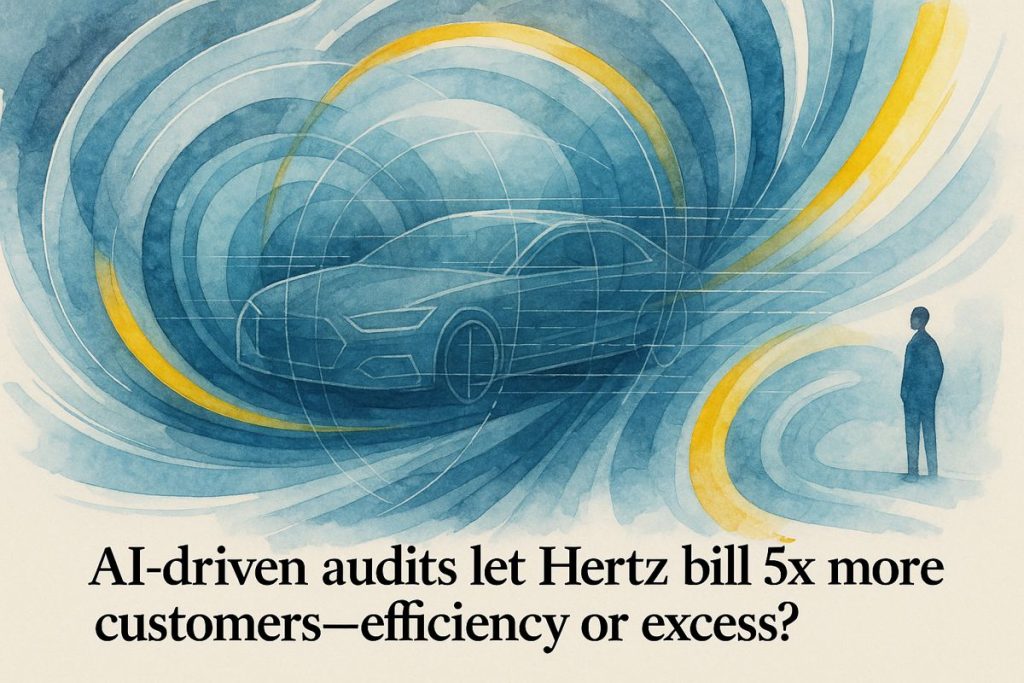Hertz is using powerful AI scanners at airports to check returned rental cars for any damage, like dings or scratches. These robots look at every inch of the car, making inspections much quicker and more accurate than before. Now, five times more customers are getting billed for damages, and everything happens digitally in minutes. While this means Hertz makes more money, some customers feel upset when charges appear for tiny marks they didn’t notice. Other rental companies are watching closely, wondering if this high-tech future is good for everyone.
How is Hertz using AI to inspect rental cars and bill customers?
Hertz uses AI-powered UVeye inspection portals at major airports to automatically scan returned rental cars for damage. These hyperspectral systems detect and document every ding, dent, and scratch, resulting in faster, more accurate inspections and a fivefold increase in customers being billed for damages, all digitally processed.
The Robo-Eye Revolution: Hertz Meets UVeye
Picture this: The hum of your rental car fades as you pull into the Hertz return lane, and instead of a human with a clipboard, a hyperspectral archway bristling with cameras stares back. No, not the opening scene from a Black Mirror reboot—just the UVeye inspection portal, now a fixture at dozens of major U.S. airports. By the end of 2025, Hertz swears these portals will be watching over 100 airport locations. I remember the first time I saw one—blinking LEDs and all—it looked more like a NASA experiment than anything from the world of rental fleets.
These AI-powered sentinels don’t just glance over your car; they scrutinize every millimetre. A scuff that might have once been shrugged off, a windshield crack like a spiderweb on a rainy night, or a tire whose tread whispers of last week’s road trip—all are meticulously catalogued. UVeye, the company behind this wizardry, calls it “automated, drive-through inspection”—which, honestly, undersells the sheer thoroughness on display. If only my last landlord had been so precise with the apartment walkthroughs.
The sensory overload is real. When the system kicks in, there’s an audible click and a soft whir—almost comforting, if you’re certain you’ve left the car spotless. But for the frazzled traveler? It’s a moment of dread: what will the machine see that I can’t?
Billing at Hyperspeed (and Scale): Five Times the Paperwork
Now, here’s where things get spicy. Hertz’s embrace of AI hasn’t just streamlined inspections; it’s supercharged billing. The numbers are staggering: five times more customers are being billed for damages than before. That’s not a typo. Fivefold. If you ever doubted the power of automation, just ask the folks at Car and Driver—their deep dive will make your coffee go cold.
Instead of waiting days for a human to fuss over paperwork, customers now receive digital notifications in mere minutes after drop-off. The company’s ERP and CRM systems, tightly integrated with the inspection data, churn out invoices with all the ruthless efficiency of a Swiss train schedule. Machine learning algorithms cross-check every result, flagging even the most arcane blemishes for billing—or at least, that’s the promise.
I’ll admit, I once thought these systems would be tripped up by a little mud or a creative parking job. Turns out, the algorithms get smarter every month, learning from their own mistakes (and, yes, from the occasional customer complaint). My initial skepticism—tinged with anxiety—has faded into a kind of nerdy admiration.
Revenue Streams and Uncharted Waters: Money Talks, Customers Chafe
There’s no denying the impact on Hertz’s bottom line. Newfound fees trickle in like rain after a drought, and when a $250 wheel scrape pops up (plus those infamous administrative charges), every penny is accounted for. View From The Wing points out how this relentless efficiency has changed the economics of the game. More cases, less overhead, fewer sleepy clerks shuffling through forms late at night.
But does it always feel fair? That’s debatable. Transparency is the new buzzword—customers are now greeted with itemized digital bills, complete with timestamped photos. On paper, it’s a triumph. In practice, the process for disputing a charge can feel Kafkaesque. According to Shub Johns & Holbrook, customers often struggle with tight deadlines and scant human recourse. Just last month, a friend of mine got dinged for a mysterious scratch. She spent an afternoon scrolling through blurry images and automated responses, the taste of frustration lingering like burnt espresso.
At first, I felt a pang of guilt for ever rooting for the robots. Then again, isn’t progress always a bit messy?
The Ripple Effect: Industry, Innovation, and the Art of Balance
Other rental giants—let’s name-drop Enterprise and Sixt—are watching Hertz like hawks circling a field mouse. When AI can recover millions in previously missed damages, it’s a siren song few CFOs can resist. Yet, as these systems proliferate, a key question simmers beneath the surface: can automation coexist with empathy, or will customers feel like data points in an algorithmic palimpsest?
I had to stop and ask myself: is this the future we want, or just the one we’re stumbling into? The paradox is hard to ignore. We crave speed and accuracy, but recoil when processes get too clinical. Hertz’s hyperspectral leap has set a new bar; whether that bar tastes like progress or a bitter pill—that’s up to each of us.
For more rabbit holes (and some juicy details), see the original sources:
- View From The Wing: Hertz Turns AI Loose On Renters
- Car and Driver: Hertz Is Using AI to Scan Your Rental Car for Damage
- Shub Johns & Holbrook: Hertz AI Scanners May Cost Consumers Hundreds
- DesignFax: Hertz’s AI drive-through scans rental cars for damage
- YouTube: Hertz AI Rental Car Damage Scanning Discussion
Progress, in all its zany glory. Or maybe just another Tuesday at the airport. Time will tell…
